Effective Techniques for Cleaning Wooden Floors
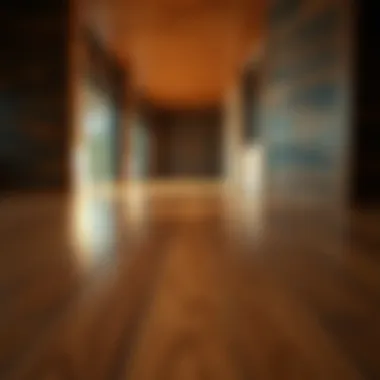
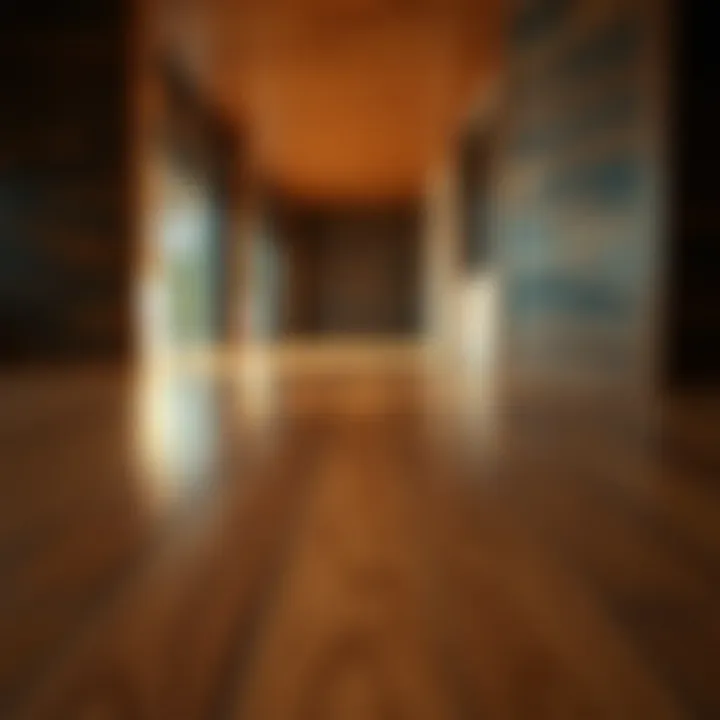
Intro
Wooden floors have long been prized for their warmth and enduring beauty. However, like any cherished possession, they require proper care and maintenance to look their best. Neglecting them can lead to dull surfaces, scratches, and, ultimately, costly replacements. In today’s fast-paced world, having a comprehensive understanding of how to clean and maintain these surfaces can be a game changer.
Not all cleaning techniques are created equal. Different wood types respond better to particular methods, and using the wrong products can do more harm than good. In this article, we will guide you through a systematic approach to cleaning wooden floors, ensuring that you keep their natural elegance intact while also protecting your investment for the long haul.
This guidance is tailored for homeowners, real estate enthusiasts, and professionals alike, offering practical advice for those who understand the nuances of maintaining wooden surfaces in their homes.
Featured Homes
When considering wooden floors, it’s insightful to look at the architectural styles that showcase their charm best. These designs not only complement the flooring but also amplify its aesthetic.
Architectural Styles
The beauty of wooden floors shines in various architectural styles:
- Victorian Homes: Characterized by intricate details and embellishments, these houses often feature ornate wooden flooring that enhances their elegance. The rich tones of hardwood provide a warm backdrop to elaborate decor.
- Craftsman Bungalows: With an emphasis on simplicity and functionality, Craftsman houses often incorporate natural wood finishes. The craftsmanship resonates well with the organic feel of wooden floors, creating a cohesive look.
- Mid-Century Modern Homes: Renowned for clean lines and minimalist aesthetics, these homes often utilize lighter wood tones that breathe freshness into the space. Simple yet sophisticated, the wooden flooring pairs seamlessly with large windows and open spaces.
Unique Design Elements
Distinct design elements also influence how wooden floors are perceived in a space:
- Exposed Beams: In homes with high ceilings, exposed wooden beams can contrast beautifully with polished floors, providing a rustic yet refined flair.
- Color Palettes: The choice of colors in furniture and walls can accentuate the beauty of wooden floors. Warm hues can make the wood appear richer, while cooler tones can balance the overall feel in a room.
Incredible Locations
Understanding where to find exemplary homes with stunning wooden floors can enhance one's appreciation for these architectural gems. The geographic highlights often dictate the style and maintenance routines of wooden flooring.
Geographic Highlights
Certain regions are more renowned for their architectural styles and wooden flooring:
- New England: Known for its colonial homes that showcase rich hardwood floors, often maintained with traditional oil-based treatments.
- Pacific Northwest: Here, cedar and fir are often used, creating vibrant and sturdy flooring options. The regions’ humid climate adds a layer of complexity to cleaning and maintenance, requiring specific approaches.
- Southern States: With many antebellum mansions, the Southern U.S. often emphasizes wider planks and intricate patterns in hardwood, necessitating special cleaning methods for upkeep.
Cultural Significance
The cultural backdrop influences the methods used in floor care. For instance, in Scandinavian cultures, there’s a strong emphasis on minimalist decor combining lighter woods with open layouts, thus impacting cleaning routines focused on maintaining brightness.
"Wooden floors are not just surfaces; they are a canvas that tells stories of the past, reflecting the artistry and culture of their surroundings."
As we delve deeper into effective techniques and practical tips for maintaining your wooden floors, it's essential to remember that each cleaning choice can either enhance or detract from their beauty. Join me as we explore methods, tools, and products suited for every type of wooden flooring, ensuring your investment in elegance remains strong.
Understanding Wooden Floors
In the realm of home interiors, wooden floors often stand out as symbols of elegance and durability. Understanding these surfaces is a crucial first step when it comes to maintaining their beauty and functionality. Wooden flooring can turn a simple room into a warm and inviting space, but without the proper care, even the finest wood can lose its luster. This section delves into the distinct types of wooden flooring available, emphasizing their unique attributes. By grasping the nuances of each kind, homeowners can make informed choices tailored to their specific needs and lifestyle.
Types of Wooden Flooring
Solid Hardwood
Solid hardwood flooring stands as the quintessential choice for many homeowners. Crafted from a single piece of timber, its allure lies in its natural grain and variations. One standout feature of solid hardwood is its ability to be sanded and refinished multiple times; this characteristic contributes significantly to its longevity. When properly cared for, solid hardwood can easily surpass decades of usage, making it a worthwhile investment.
However, it does have its pitfalls. Solid hardwood can be affected by humidity changes, causing it to expand or contract. Additionally, installing it in moisture-prone areas like basements isn't advisable. For those looking for a classic option that ages beautifully, solid hardwood is often regarded as one of the top choices.
Engineered Wood
Engineered wood flooring brings a blend of style and resilience to the table. Unlike solid hardwood, this type consists of multiple layers, with a top layer of hardwood bonded to core layers of plywood or fiberboard. This construction allows engineered wood to maintain its shape better under varying humidity levels, making it an excellent choice for spaces prone to moisture.
A notable advantage is its installation versatility; it can be glued, nailed, or floated over existing floors, reducing labor costs. Nevertheless, it generally can’t be refinished as much as its solid counterpart, which can be a drawback for those focused on long-term maintenance.
Laminate Flooring
Laminate flooring isn't technically wood but mimics its appearance stunningly. Comprised of high-density fiberboard with a photographic layer that resembles wood grain, it is remarkably budget-friendly. One of its key characteristics is durability, standing up quite well to scratches and dents. This makes it a fitting choice for households with pets or young children.
Although it’s easy to clean and maintain, laminate can't be sanded or refinished, meaning any deep scratches or significant wear will require replacement. Thus, those shopping for a more economical option without sacrificing appearance might find laminate flooring appealing, but they should also be aware of its limitations.
Importance of Proper Maintenance
Maintaining wooden floors goes beyond mere aesthetics; it affects their longevity and usability in everyday life. A lack of proper care can result in visible damage, leading to costly repairs or replacements.
Longevity of Flooring
The longevity of flooring hinges on the adherence to maintenance routines. Proper care involves regular cleaning and avoidance of harsh chemicals that might strip away protective finishes. Notably, hardwood floors can last for generations if treated right. Regular inspections are essential to catch any issues early, such as loose boards or small scratches, which can worsen over time.
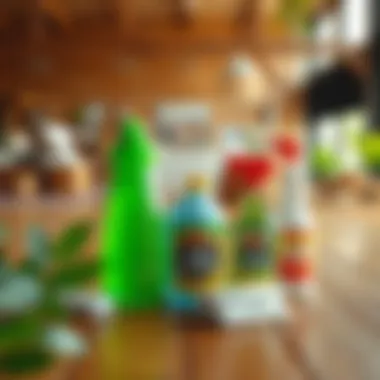
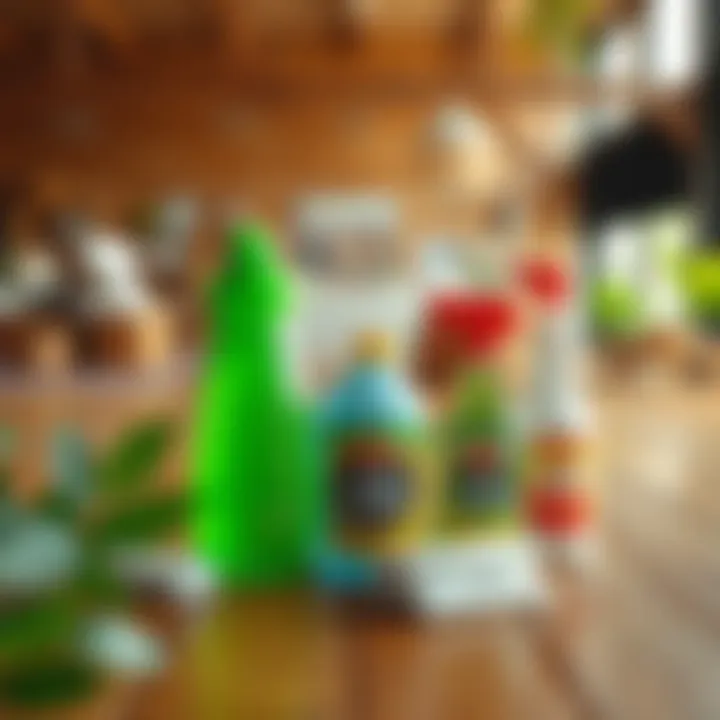
An effective maintenance schedule not only preserves the floor’s integrity but also saves homeowners from unexpected costs related to major repairs.
Preservation of Aesthetic Appeal
Along with functional benefits, maintaining wooden floors greatly contributes to their aesthetic appeal. A well-kept wooden surface enhances the overall ambiance of a home. Routine cleaning, coupled with the occasional refinishing, ensures that the natural beauty of wood shines through.
In summary, understanding the types of wooden flooring and the importance of maintenance can empower homeowners. This knowledge equips them with the ability to choose the right floors and keep them looking their best for years to come.
Initial Preparations
Initial preparations are a crucial step before diving into the cleaning process of wooden floors. Much like a painter before touching a brush to canvas, taking time to properly prepare sets the stage for effective cleaning. Understanding your floor’s condition and having the right tools at hand can save you time, effort, and potential damage down the line.
Assessing the Floor's Condition
Identifying Damage
Identifying damage is an essential aspect of maintaining the integrity of wooden floors. Look for cracks, warps, or areas where the finish has worn off. Spotting these problems early on is like finding a needle in a haystack; it’s not easy, but doing so allows you to tackle these issues before they worsen. Not only does it invite you to course-correct, but it also helps in deciding the best cleaning measures to adopt.
If you ignore damage, you might end up aggravating it. For instance, using too much water on already warped boards could lead to further swelling and deterioration. Thus, knowing what you’re dealing with is half the battle.
Determining Necessary Cleaning Measures
Once you’ve assessed the floor’s condition, it’s time to determine necessary cleaning measures. This involves reading the warning signs identified and translating them into actionable steps. For instance, if you've noted extensive scratches, you may need more than just a quick mop; perhaps a specific polish or repair treatment is in order.
What’s beneficial about this step is that it tailors your cleaning approach to your unique flooring situation. Some floors may require gentle solutions, while others can handle a bit more elbow grease. Knowing the specifics not only helps in maintaining the floor but also keeps the aesthetics intact, allowing the wood's natural beauty to shine through.
Gathering Essential Supplies
Mops and Buckets
Mops and buckets might seem like an ordinary duo, but they play a vital role in the cleaning process. A good mop is like a trusted steed; it helps you cover ground efficiently and with finesse. When it comes to wooden floors, a microfiber mop is often recommended. Its ability to trap dirt and dust without scratching the wood is a distinguishing factor.
On the other hand, using a standard mop can leave behind moisture, which is not ideal for wooden surfaces. So, grabbing a specialized mop can be a game-changer; ensuring longevity for your wooden floors should never be overlooked.
Detergents and Wood Cleaners
Having the right detergents and wood cleaners is essential for achieving a deep clean without causing harm. Not all cleaners are created equal, especially when it comes to wooden surfaces. Look for pH-balanced solutions that won’t strip the wood of its properties; this is where knowledge comes in.
Some may prefer natural options like vinegar or olive oil for cleaning, applying those with consideration of their unique feature—non-toxicity. However, they can lack the punch needed for more serious grime. Thus, identifying the cleaner that suits your floor’s finish is key.
Microfiber Cloths
Microfiber cloths are a must-have when caring for wooden floors, as they offer a gentle yet effective cleaning method. Their fine fibers can pick up dirt and moisture while protecting the delicate finish of the wood. Unlike regular cloths, which can leave lint and scratches, microfiber cloths excel in combining absorbency with non-abrasiveness.
These cloths are also easy to wash and reuse, making them an economical and eco-friendly choice. In a world where sustainability is becoming paramount, investing in microfiber cloths aligns well with responsible maintenance practices.
In summary, being prepared is not just about having tools and supplies; it’s about knowledge, foresight, and the thoughtful application of resources. Each step taken in the initial preparations paves the way for a smooth, effective cleaning process that respects the beauty and integrity of your wooden floors.
Cleaning Methods
The topic of cleaning methods is pivotal when it comes to preserving wooden floors. Each approach has its ups and downs, contributing either to maintaining the beauty or, conversely, possibly harming the surface. Knowing the right techniques can make a world of difference, ensuring that the elegant look of the wood stays intact while also maximizing its lifespan. Adopting proper cleaning methods not only enhances the aesthetic appeal but also promotes an environment that is healthier for you and your family.
Basic Cleaning Techniques
Dry Mopping
Dry mopping is often the first line of defense in maintaining wooden floors. This technique involves utilizing a dry mop or a microfiber cloth to capture dust and dirt without the need for water or cleaning solutions. The key characteristic of dry mopping is its ability to sweep up loose debris efficiently, without risking moisture damage.
One significant advantage of dry mopping is that it can be done frequently—daily if needed—and it’s ideal for those quick touch-ups between deeper cleanings. However, it might not be adequate to tackle stubborn grime or sticky residue.
Sweeping Strategies
When it comes to sweeping strategies, there’s more than meets the eye. Sweeping effectively requires understanding which tool suits the task. A soft-bristle broom is typically the best option for wooden floors as it won't scratch the surface. This technique is quite pivotal, serving the dual purpose of routine upkeep and making prep for deeper cleaning simpler.
The key advantage of incorporating sweeping into your routine lies in its simplicity and effectiveness. It provides an accessible approach that anyone can master. Yet, the downside is that it may not be 100% effective at capturing fine dust or pet hair that can cling stubbornly to the floor's surface.
Wet Cleaning Approaches
Using Damp Mops
Utilizing a damp mop is a more intensive approach than dry cleaning methods. The damp mop technique employs a slightly wet cloth to lift dirt without saturating the wood. The key element here is the moisture control; too much water can warp the wood, while just enough can help restore its sheen.
Damp mopping is beneficial because it can eliminate that persistent grime that dry methods leave behind. However, users must be cautious regarding the moisture level, as excessive water can lead to long-term problems, such as buckling or cupping in the wood.
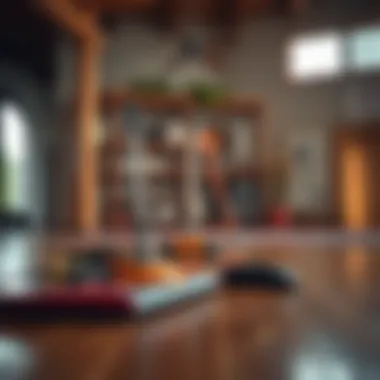
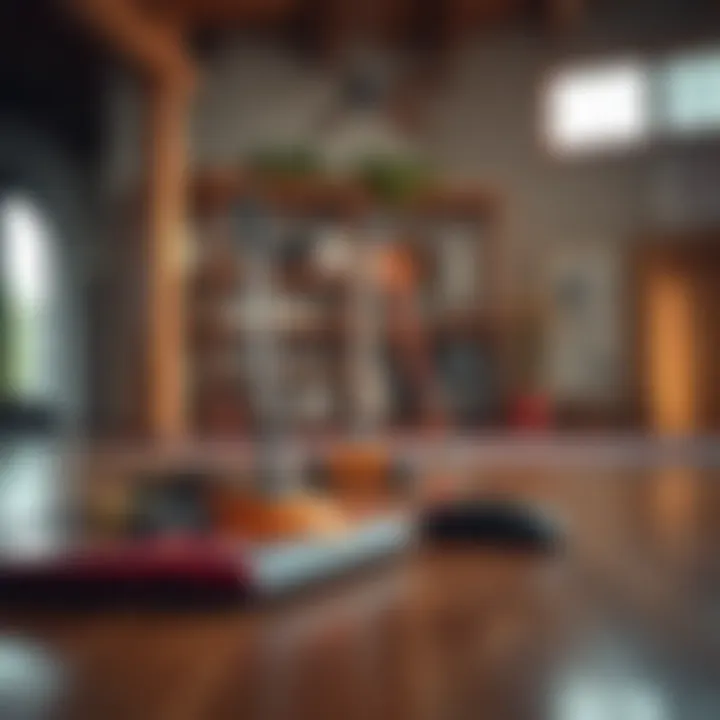
Recommended Cleaning Solutions
When it comes to recommended cleaning solutions, selecting the right product is critical. Specialized wood cleaners are often the best choice, as they are designed to clean effectively while respecting the wood's finish. For instance, a pH-neutral wood cleaner is typically a good bet, striking a balance between effectiveness and gentleness on delicate surfaces.
However, using improper cleaning agents, like harsh soaps or all-purpose cleaners, can strip the wood of its protective finish, causing irreparable harm. So, it’s vital to read labels and, ideally, perform a patch test before diving headfirst into cleaning.
Dealing with Stains and Marks
Types of Common Stains
Understanding types of common stains can facilitate making informed decisions on treatment. For example, food spills, pet accidents, and water rings are a few culprits that often plague wooden floors. Identifying these types quickly not only tags in urgency but also enables you to utilize the right approach to cleaning.
Each stain requires a different treatment method, and being aware of the specificities can save both time and effort.
Specific Treatment Techniques
Specific treatment techniques make a world of difference in stain removal. Strategies can range from using mild soap and water for food stains to specialized wood stain removers for more tenacious marks. The unique feature of these treatment options is that they can vary in effectiveness based on the wood finish that’s been applied.
While some techniques may work wonders on certain finishes, they could potentially cause damage on others. Thus, adhering to the type of wood and its finish can significantly enhance the chance of successful treatment.
Remember, the proper selection of cleaning methods and products is key to maintaining the beauty and longevity of your wooden floors.
Deep Cleaning Procedures
Deep cleaning wooden floors is a critical part of floor maintenance that often gets overlooked in the rush of daily life. Unlike the regular sweeping or mopping, deep cleaning asserts itself as a thorough approach, tackling ingrained dirt and stubborn stains, while also preventing long-term damage to the wood. This section will cover how often to deep clean, detailed steps for an effective clean, and why this process is paramount to preserving the elegance of your wooden floors.
Frequency of Deep Cleaning
Recommended Schedule
When it comes to deep cleaning wooden floors, timing is key. A recommended schedule for deep cleaning could be once every three to six months, depending on the traffic your floors endure. For homes with children or pets, leaning towards the more frequent end of that spectrum is wise. This practice not only rejuvenates the floor's appearance but also prolongs its lifespan.
The key characteristic of this schedule is simplicity; it's a straightforward way to ensure that your floors don't accumulate dirt and grime.
One could argue that a consistent deep cleaning rhythm stands out as a popular choice for enthusiasts who value their interiors. However, it’s essential to tailor that schedule based on lifestyle. A unique aspect of this timing is that it helps in recognizing any developing issues, like warping or discoloration, before they escalate. Overall, maintaining a deep cleaning schedule ensures that your investment in wooden flooring remains visually stunning and structurally sound.
Factors Influencing Cleaning Frequency
Several factors influence cleaning frequency, determining how often you should roll up your sleeves for a deep clean. The nature of your household is a prime consideration; high-traffic areas, particularly where kids and pets play, will require more attention than quieter corners. For instance, kitchens often witness spills and stains that necessitate more frequent cleaning.
Another important factor includes the type of wood used for flooring. Softer woods might demand more frequent deep cleans as they can show wear more easily compared to harder varieties. Environmental aspects like humidity and dust levels inside your home can also impact how quickly dirt builds up. Recognizing these factors contributes to a tailored cleaning approach, helping you determine the right balance between effort and floor care.
Step-by-Step Deep Cleaning
Preparation Steps
Planning is half the job when it comes to preparation steps for deep cleaning wooden floors. Firstly, it's crucial to clear the area of furniture and decor to gain access to every nook and cranny. Having a clean slate makes the job easier and ensures you won’t leave any parts unattended.
The key characteristic of preparation is organization—having all your tools ready before diving in. This readiness makes for an efficient cleaning process, allowing you to tackle everything swiftly and without interruption. One unique feature of proper preparation is that it aids in spotting any pre-existing issues with your floor that might need addressing before they worsen. Ultimately, thorough preparation not only enhances the cleaning process but also allows for a more satisfying outcome.
Assigned Tasks
In any deep cleaning operation, having clearly defined assigned tasks can make the process less daunting. Breaking down the cleaning job into manageable smaller tasks ensures no stone is left unturned. One might designate areas to different members of the household or assign tasks based on individual strengths—maybe one person is particularly adept with cleaning solutions, while another handles moving furniture.
The structure provided by assigning tasks brings an organized approach, promoting efficiency and clarity. This method can turn what often feels like a burdensome chore into a collective effort. Furthermore, it encourages everyone involved to take an interest in maintaining and caring for the space they inhabit. So, while it might require some initial coordination, the advantages of a well-organized deep cleaning session often lead to thorough results with shared satisfaction.
Aftercare for Wooden Floors
Proper care for wooden floors is absolutely vital. It doesn’t just preserve their beauty; it significantly prolongs their lifespan. Aftercare encompasses all the necessary steps post-cleaning that ensure your wooden flooring remains in top shape. Giving attention to aftercare means addressing the subtle wear and tear that may not be immediately visible but can lead to bigger issues down the road.
Regular Maintenance Tips
Preventative Measures
Looking after your floors doesn’t stop at just one cleaning session. Preventative measures are all about being ahead of the curve. They involve strategies that can help you dodge major clean-up jobs or expensive repairs down the road. One such measure is placing mats at entry points. They catch dirt and moisture before it hits the floor.
Another practical tip is to avoid using rubber or plastic furniture pads. These can retain moisture and create potential damage over time. Instead, go for felt pads. They are easy to find and do wonders in keeping the floor unscathed.
A key component of preventative measures is controlling humidity. Excessive moisture can lead to warping. Hence, maintaining humidity levels through a dehumidifier or air conditioning can really help in keeping your floors solid and intact. Overall, the allure of preventative measures lies in their simplicity and effectiveness. Being proactive now can save you a headache later on, that is for sure.
Routine Care
Routine care is practically the bread and butter of keeping wooden floors in good shape. Having a consistent cleaning schedule ensures that dirt accumulates less and scuffs are minimized. Think of it as a regular visit to the doctor; it seems mundane but can make all the difference in the long run.


Sweep or vacuum regularly with a soft brush or floor attachment. This prevents grit from scratching the surface. Daily upkeep might sound like a drag, but it only takes a few minutes a day and makes your cleaning sessions less labor-intensive. A special touch like using a microfiber mop, which captures debris instead of just pushing it around, can elevate the outcome of routine cleanings.
A unique feature of routine care is its adaptability. You can tailor it to your lifestyle—if you have pets, for instance, you may need to sweep more often. The beauty of routine care is its flexibility; it’s about making small changes in your daily life that lead to significant results without upheaving your routine.
Addressing Scratches and Scuffs
Identifying Types of Damage
Before you can fix anything, you gotta know what you’re dealing with. Identifying types of damage is essential because it guides your next steps. Scratches, for example, can vary from light surface scuffs to deeper grooves that need special treatment. Knowing how to spot these distinctions will save you time and prevent unnecessary expenses in trying solutions that may not work.
A quick assessment involves running your fingertips over the floor; if you can feel it, it might need attention. Surface scratches can often be covered up with a simple wax or polish that matches your floor's finish. Meanwhile, more significant issues like warped or chipped boards will require a completely different approach.
Understanding the type of damage allows you to customize your repair method, leveraging the right tools and products for effective restoration.
Available Repair Solutions
When it comes to repair solutions, they range from the quick fixes to full-blown professional services. Simple scratches might just need a little wax to buff them out, while deeper scratches or gouges may call for specialized wood fillers. The difference lies in what kind of repair you are tackling.
A big advantage of available repair solutions today is the variety. Many commercial products cater to different types of finishes and damages, allowing homeowners to DIY. However, sometimes professional help is warranted, like when a board needs to be replaced entirely. There can be drawbacks, though; opting for DIY methods might not always give you the level of finish that matches the rest of the floor.
So, understanding available options not only simplifies the process but also emboldens you to take care of small issues before they escalate into something larger. You learn that each specific repair solution has its own set of pros and cons, and discovering them is part of the maintenance journey.
Sustainable Practices for Wooden Floor Care
Sustainable practices in the care of wooden floors serve a dual purpose: they not only enhance the longevity and appearance of the flooring, but also contribute to the overall health of our planet. As homeowners and professionals alike become more conscious of environmental issues, incorporating eco-friendly approaches in floor care grows increasingly important.
Choosing Eco-Friendly Products
When selecting cleaning products for wooden floors, opting for eco-friendly solutions can yield notable health benefits for both your family and the surrounding environment.
Benefits of Green Cleaners
Green cleaners stand out due to their non-toxic and biodegradable properties, making them a safe choice for households with children and pets. These products eliminate harsh chemicals without sacrificing cleanliness. This characteristic greatly appeals to those looking for effective but gentle cleaning options.
The unique feature of green cleaners lies in their formulation, derived from natural ingredients that are just as effective in eliminating dirt and grime as traditional cleaners. Nevertheless, while they do not always carry the same strong scents as conventional options, their natural fragrances can be refreshing in a home environment.
Impact on Environment
The use of eco-friendly cleaning products significantly reduces hazardous waste. When you choose cleaners that aren't made with synthetic chemicals, you lessen pollution and help conserve natural resources. This commitment reflects a growing trend of responsible consumerism in today’s society.
A major characteristic of prioritizing environmental impact reveals itself with the reduction of carbon footprint. Natural products not only break down easier but also lessen the chances of chemical runoff into water streams, positively influencing local ecosystems. Awareness of their environmental impact tends to make these options more attractive for conscientious homeowners.
Waste Reduction During Maintenance
Another pillar of sustainable wooden floor care revolves around waste reduction. It’s not just about what you use, but also how you use it, and how you deal with unused cleaning supplies.
Proper Disposal of Unused Products
Proper disposal of leftover cleaners is vital in minimizing landfill waste. Many household items, often ending up discarded without a second thought, can be repurposed or recycled. This practice not only reduces clutter but also fosters responsible consumption behaviors.
One key aspect of this is being aware of local disposal guidelines. Many communities offer specialized disposal sites for hazardous materials, ensuring these items are handled correctly. By following these practices, you not only do your part in keeping your home clean and safe, but you also contribute to a more sustainable community.
Using Renewable Cleaning Materials
Choosing renewable cleaning materials adds another layer of sustainability in floor care. Using microfiber cloths or reusable mops cuts down on single-use disposable products, minimizing waste generated during cleaning routines.
These materials often outperform their disposable counterparts, offering not just environmental benefits, but also economic savings in the long run. Over time, investing in quality, refillable tools translates into reduced costs and a healthier environment. Such practices represent a shift towards a more thoughtful way of caring for wooden floors.
Finale
Cleaning wooden floors is not just about maintaining a clean surface; it’s about preserving the often substantial investment made in these beautiful materials. A well-kept wooden floor enhances the aesthetic appeal of a space, adds to the overall value of a home, and ensures that the wood remains resilient against wear and tear over the years.
Understanding the myriad cleaning methods and products available is essential for homeowners and professionals alike. With regular maintenance, deep cleaning routines, and the right eco-friendly products, one can effectively extend the lifespan of wooden flooring. An informed approach means not only using the right tools and cleaners but also knowing when to apply each method appropriately.
"An ounce of prevention is worth a pound of cure"— this saying rings true when it comes to wooden floor care. By prioritizing the right cleaning practices, homeowners can sidestep extensive repairs in the future.
Summary of Key Points
- Types of Wooden Flooring: Knowing the difference between solid hardwood, engineered wood, and laminate flooring is crucial for applying the correct cleaning technique. Each type has its own needs and vulnerabilities.
- Assessment of Floor Condition: Always evaluate your floor before proceeding with any cleaning process. Identify any damages and take appropriate measures for repair.
- Preparation is Key: Gather all necessary supplies. This includes mops, vacuum cleaners, and wood-safe detergents to avoid accidental harm.
- Different Cleaning Techniques: Employ a mix of dry and wet methods. Regular sweeping or vacuuming reduces dirt and dust, while wet cleaning refreshes the surface and ensures deeper cleaning when needed.
- Sustainable Cleaning: Opt for eco-friendly products to minimize environmental impact. These products can be just as effective while being safer for both the user and the surrounding environment.
Final Thoughts on Floor Care
Ultimately, success in maintaining wooden floors boils down to knowledge and routine. The right approach balances the need for cleanliness with preservation tactics tailored to the specific type of wood and its finish. With a strong understanding of both cleaning methods and preventive measures, house owners can ensure their wooden floors not only look appealing but are also durable and resilient.
Moreover, as tastes and preferences evolve in interior design, staying informed about new products and methods is vital. Trends are always shifting, and so should your approach to floor care. You don’t need to reinvent the wheel but recognizing what's new can keep those expansive wooden surfaces shining like new.
Keep in mind that every floor tells a story—it’s worth investing the effort to ensure it’s one of elegance and longevity. For further insights and discussions, consider exploring online forums, articles on sites like rahman.com, or communities on reddit.com.
With careful consideration and diligence, maintaining the splendor of wooden floors can be a rewarding endeavor.















